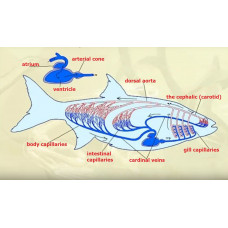The circulatory system is a closed system of vessels through which the blood circulates. The main functions: trophic (transport of nutrients), excretory (removal of metabolic products to the excretory organs), respiratory (transport of oxygen to tissues and carbon dioxide to respiratory organs), protective (contains cells capable of destroying foreign agents) and regulatory (transfer of hormones and other active substances from the glands of internal secretion to tissues and organs). The lymphatic system is represented by lymphatic vessels, in which lymph is collected from the organs and the same is discharged into the Cuvier ducts. Some fish have lymphatic hearts. In cartilaginous fish first appears spleen - a large compact organ that serves as a blood depot and serves as a hematopoietic organ.
Most fish have one circulatory circle and a two-chambered heart. Double-breathing fish have two circulatory circles and incomplete septa in the atrium and ventricle. The circulatory system is closed, transporting blood from the heart through the gills and body tissues. Unlike the heart of other vertebrates, the heart of fish is not adapted to separate (even partially) enriched oxygenated blood (arterial) from unenriched (venous). Structurally, the fish heart is a sequential series of chambers filled with venous blood: venous sinus, atrium, ventricle, and arterial cone. The heart chambers are separated by valves that allow blood to move in only one direction (from the venous sinus to the arterial cone) during heart contraction, but not vice versa.
Circulatory system
Tags: circulatory system

